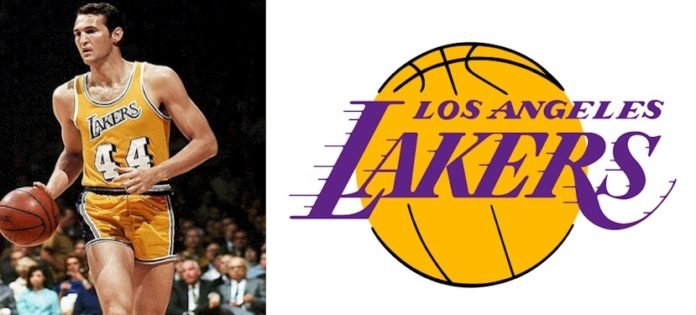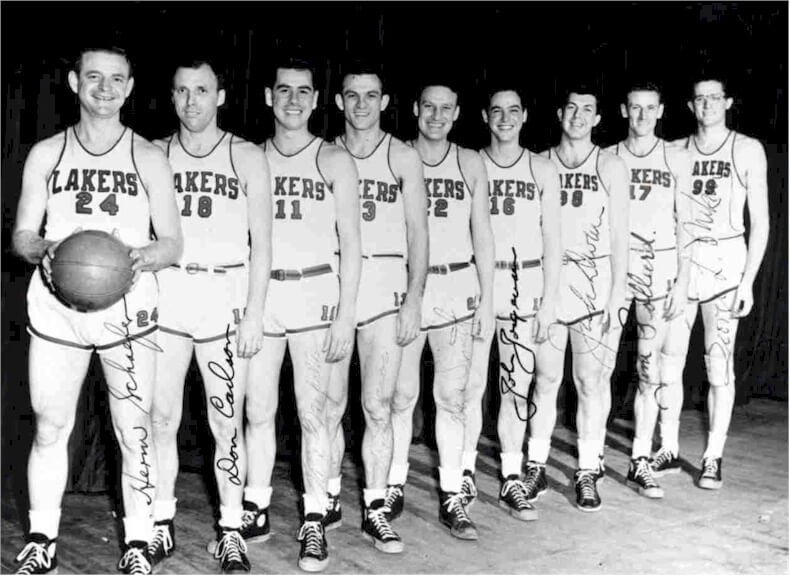Let’s take a look at the Los Angeles Lakers Logo and the History of the Team
The LA Lakers have shown off their iconic logo for most of the team’s existence. The simple but recognizable logo consisting of a purple “Los Angeles Lakers” wordmark over a gold-colored basketball has endured for decades with minimal color and font changes.
The visual center of the Lakers logo, the “Los Angeles” logotype, has stayed the same since the 1960s, while the gold basketball has gone through subtle color changes over the years. 2001 saw the last logo redesign; it was given a black outline and more robust colors, making the emblem pop even more.
The Lakers Logo History

Although the Lakers have been synonymous with Los Angeles for most of their history, the team was first based in Minneapolis. It was named “Lakers” as an homage to the more than 10,000 lakes in the state.
The first version of the Lakers logo featured a map of Minnesota, the team’s original home state, on a brown and black outline of a basketball and a yellow star on the map denoting Minneapolis’s actual geographical position. Moreover, the map also bore the wordmark “MPLS,” which featured a star at the beginning and the end and the word “Lakers” at the bottom.
The Lakers left Minnesota in 1960, moving West and settling in Los Angeles, California. As most teams do when moving from one state to another, the Lakers decided to rebrand. The team dropped “Minnesota” from their name in favor of Los Angeles but kept “Lakers,” becoming the Los Angeles Lakers. By 1961, the team was sporting the iconic LA Lakers logo, consisting of the “Los Angeles Lakers” wordmark in red-purple over a greenish basketball.
In 1976/77, the team made slight color alterations to the logo. The wording was lightened to a light purple lilac while the green of the ball became yellow. The basketball’s seams were also flipped to face the other way, and a darker outline was added to it, giving the design more clarity.
The Los Angeles Lakers Logo Evolution

For most teams in the NBA, moving states is typically followed by rebranding. During the team’s years in Minnesota, its logo was decidedly less colorful, with the players’ t-shirts sporting an abstract bright yellow logo and nothing much else. When the team moved to Los Angeles, however, their logo, as well as their uniforms, became much more stylish. Here’s how the Lakers logo has evolved over the years.
Minneapolis Lakers Logo (1948-1960)

The Lakers had their first run back in the late 1940s as the Minneapolis Lakers. Their original team logo, though not as colorful as the current one, was quite eye-catching. It featured a yellow basketball designed to look like a globe with a white shock map of the then home state Minnesota inside the ball.
A small, yellow, five-pointed star in the white map marked Minneapolis’s geographical position. The abbreviation “MPLS” was right above the basketball with a star before and after the wordmark, while “LAKERS” was below it.
The Minneapolis Lakers used this logo until 1960 when they moved to Los Angeles, California, and changed their name to Los Angeles Lakers.
Los Angeles Lakers Logo (1961-1976)
After moving states from Minnesota to California, the Lakers rebranded and took on a whole new look. The only component retained from the original logo was the ball. The yellow became a dark, grainy green while the team name was moved to the basketball center. Instead of sporting “MPLS LAKERS,” the logo proudly proclaimed “LOS ANGELES LAKERS” in dark purple.
The purple inscription was divided into two lines— “Los Angeles” and “LAKERS” in a much larger font. The larger “LAKERS” wordmark has perpendicular lines stretching out towards the left, creating the impression of motion.
1977-2001
Once the team was rebranded as the Los Angeles Lakers, the Lakers logo remained unchanged until 1997, when its primary colors were updated. The ball’s main lines changed from white to black while the ball itself changed from a grainy green to orange, dark purple, and finally light blue. Additionally, the basketball’s seams, which initially faced right, were flipped to face the opposite direction.
The color for “LOS ANGELES LAKERS” was updated to a cleaner, brighter shade of purple while the horizontal lines streaming off “LAKERS” became thicker, creating an even greater impression of speed and motion. The final changes were made back in 2001 and, since then, subsequent updates have been quite minimal, focusing on enhancing the colors and nothing else.
2002 – Present
Through some messing about with color saturation, designers improved the clarity of the logo in 2002. Other than making the golden, black, and purple colors more saturated to improve color clarity, the logo hasn’t experienced any significant changes since 2002.
The LA Lakers Logo Elements
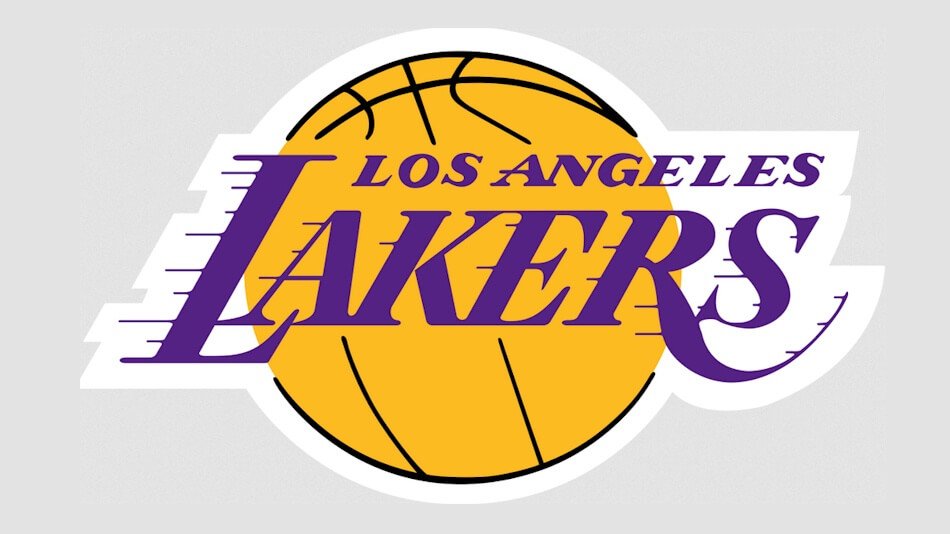
The original Minneapolis Lakers logo consisted of a basketball and the team name. Besides the color changes, the wordmark repositioning, and the switch from “MPLS” to “Los Angeles,” the current logo has remained relatively faithful to the original.
The current logo featuring a basketball with distinctively traced seams and the full name Los Angeles Lakers written across it in purple and motion lines streaming away from it has become one of the most recognizable symbols in the NBA.
The Lakers emblem: The distinctive wordmark is the emblem’s visual center. Originally going by “MPLS LAKERS,” the logo now states “Los Angeles Lakers” in dark purple. This inscription is placed right on top of a gold basketball rather than above and below it like in the original logo. Thanks to a black outline, the colors pop more, making the emblem stand out.
Lakers Logo Font: The Los Angeles Lakers Logo utilizes the “Bodoni” font in its logo. The club does not own this font, but they bought the rights to use it. The font is a serif type and is in italics, and it’s also adorned with decorative elements.
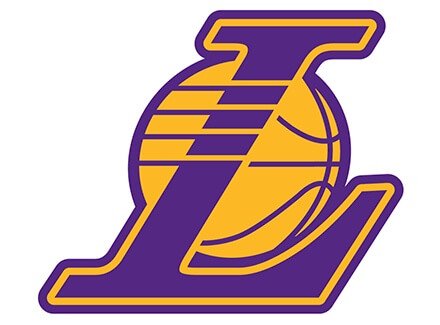
One of the more peculiar logo elements of the wordmark is the lines that stretch out horizontally to the left. These “motion lines” were first used in the earliest version of the logo back in 1960.
Color: This version of the Lakers’ logo has seen various color changes since it was introduced in 1960. Currently, it comprises purple, gold, and white—the team’s primary colors. This color scheme, which is also used for the team’s uniforms, was introduced in the 1960s and has only seen minor hue alterations since then.
Los Angeles Lakers Club History
Arguably one of the most popular and successful franchises in the National Basketball Association (NBA), the Los Angeles Lakers were founded in 1947 as the Minneapolis Lakers. By the close of 2020, the team had won 17 NBA championships, held records for wins with 3,125 wins, winning percentage (.786), and NBA final appearances (32). The Lakers are tied with the Boston Celtics for the most championship wins in NBA history, with both franchises accounting for 45.9% of the NBA’s 74 championships.
Since the Lakers have made far more final appearances than the Celtics (15 vs. 4 in being runner up), they are essentially the most successful basketball franchise to date.
Lakers Beginnings in Minneapolis (1947-1958)
The “Lakers” name was first slapped onto a basketball jersey back in 1947 when Morris Chalfen and Berger Morris of Minnesota purchased the recently disbanded Detroit Gems of the National Basketball League (NBL) from Gems founder and owner C. King Boring and business partner Maury Winston. The two bought the disbanded franchise for $15,000, relocated it to Minneapolis, and christened it the Minneapolis Lakers, about Minnesota’s nickname, The Land of 10,000 lakes.
However, as all the players had been assigned to other NBL teams with the Detroit Gems on the verge of collapse, the “team” consisted of only just the equipment. Berger and Chalfen brought in Max Winter, who later became founder and owner of National Football League’s (NFL) Minnesota Vikings. Winter also bought an ownership stake in the Lakers, a stake he held until he left the team in 1955.
Being the worst performing team in the NBL, the Detroit Gems, now christened the Los Angeles In 1947 the Lakers had the first pick in the Professional Basketball League of America dispersal draft. The team snagged George Mikan, who became one of the greatest centers of his time, and the Lakers’ first coach John Kundla rounded the squad up with former University of Minnesota players. Foreshadowing the Lakers’ future greatness, the team won the NBL championship in their first season.
The Minnesota Lakers as Champions (1949-1950)
The Minnesota Lakers switched to the 12-team Basketball Association of America (BAA) the next year and won the championship in 1949. With Jerry West playing the guard position, the Minnesota Lakers made nine appearances in the NBA finals. After retiring from playing, West took over as the team’s coach for three years. Dubbed “Mr. Clutch,” West holds the record for the highest points per game average in a playoff series (46.3), and his silhouette has been incorporated into the NBA’s iconic logo.
In 1958, the Lakers used the number one overall pick in the 1958 NBA draft to pick Elgin Baylor right out of school. Baylor averaged 24.9 points per game as a rookie, 15.0 rebounds per game, and was given the award of the NBA Rookie of the Year Award for the 1958-1959 season. In 1959, he and Vern Mikkelsen led the team past the Atlanta Hawks to the finals, but they were also defeated by the Boston Celtics, setting the stage for a decades-long rivalry between the two franchises.
Move to Los Angeles (1958-1968)
Seeing how successful the Brooklyn Dodgers’ move to Los Angeles was, the Minnesota Lakers owner considered moving the team to the City of Angels as well. With suitable climate conditions, minimal competition, and a megapolis status, there was much to gain from such a move. Thus the Minnesota Lakers moved to Los Angeles, California, during the 1960-1961 season and changed their name to the Los Angeles Lakers.
The Showtime Era (1984-1985)
By the 1984-1985 season, the LA Lakers had finally found their rhythm. The team’s “Showtime” era, characterized by a mix of “no-look passes off the fast break, pin-point alley-oops from half court, spinning feeds, and overhand bullets under the basket through triple beans,” was in full swing. For the fourth straight year, the team won the Pacific Division with an NBA record 20 games ahead of second-place Portland this time. Also, the Lakers also set team records for total assists (2,575) and field-goal percentage (545).
Bryant and Gasol Years (2007-2014)
April 2008 saw the Lakers surge to the Western Conference’s top thanks to a stellar performance by season MVP Kobe Bryant. Coupled with Marc Gasol’s versatile abilities and Lamar Odom’s inspired performance as a third option, the Lakers won the Pacific Division from the Phoenix Suns. They clinched their playoff berth for the 55th time and the number one seed in the Western Conference for the first time since the 1999-2000 season. Kobe Bryant was also named the 2007-2008 NBA most valuable player for the first time in his career.
Lebron Era (2018 – present)
The Lakers made the playoffs during the 2019-2020 season for the first time since 2013. They qualified for the 2020 NBA playoffs with a 52-19 record for the 17th time in the franchise’s history. However, the COVID-19 pandemic severely disrupted the season, with several players contracting the virus and the 2020 season being postponed to accommodate lockdown and social distancing orders.
Games later resumed at Disney World in Orlando under stringent health measures to keep players safe. The teams essentially moved into the center, with games being played in the same arena with no fans and just a few spectators to mitigate the virus’s spread. Despite these setbacks, the Los Angeles Lakers won the 2020 NBA Championship.
Wrapping Up the Lakers Logo & History
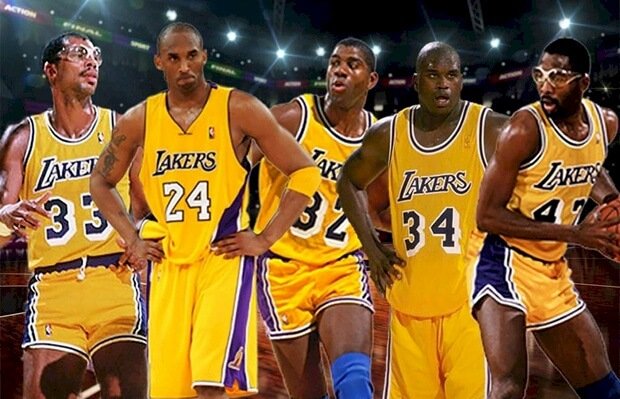
Decades old and still going strong, the LA Lakers Logo and the Lakers have become one of the most successful sports franchises in American sport. The team has nurtured plenty of talented players over the years, including but not limited to Jerry West, Wilt Chamberlain, Elgin Baylor, Kobe Bryant, and Lebron James.
With a nearly $1 billion valuation, several NBA records, and a never-ending roster of super talented players, the Lakers can only go up from here.

